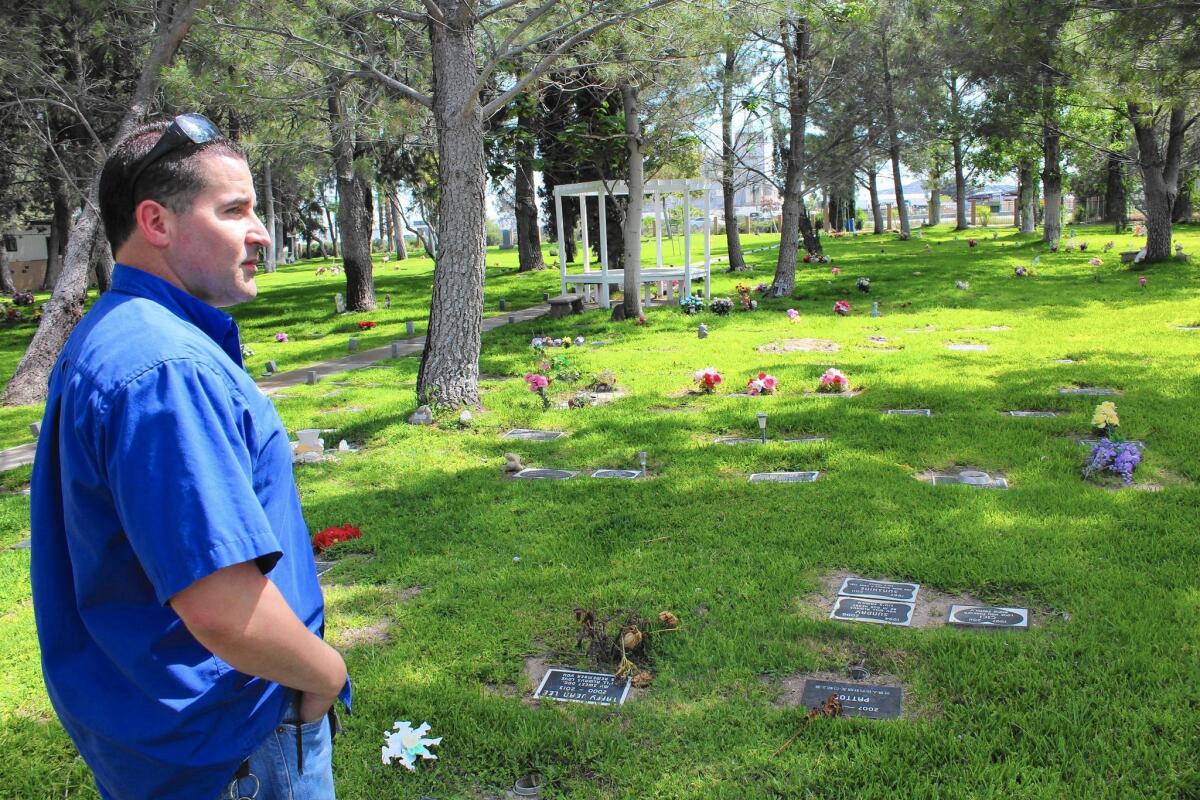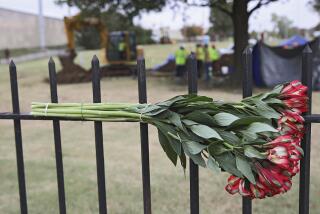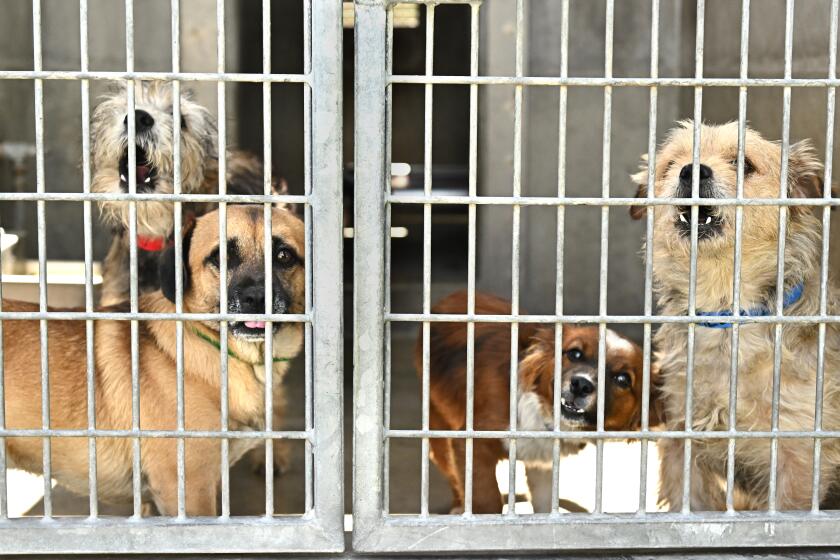How burial, memorials and support groups can ease the pain of a pet’s death

When a pet dies, the human survivors face a series of practical decisions: how to dispose of the remains, how (and whether) to inform friends and colleagues. Many of us will ponder a memorial or a tribute on social media. And some of us will seek assistance in dealing with grief, which can’t be put away as easily as a water dish and a chew toy.
A place to rest
Nestled in a leafy glade along the 215 Freeway, San Bernardino’s Gateway Pet Cemetery & Crematory includes tidy rows of small headstones that break up a great expanse of grass. On a Monday afternoon, even with the constant thrum of life on the nearby highway, Gateway felt like a tranquil place.
The cemetery, which opened in 1959, long before the freeway came through, is one of several in California (there are hundreds nationwide). During a tour of the grounds, Justin Crumlish, who runs the cemetery with his wife, Danielle, listed their services: standard cremations, burials, viewings, paw prints, poems and memorials tailored to each client’s wishes.
“I’m in the business for people dealing with grief,” Crumlish said.
The cost for burial services at Gateway averages $400 to $500. Cremations without burial are much less expensive, starting at $80. The fees include perpetual care and maintenance of the grounds, and a key that allows unlimited access to the cemetery. “I have a lot of clients, a lot of people to take care of, and that’s my main goal,” Crumlish said.
Tombstones are engraved with acknowledgments of devotion: “Best friend,” “Always in our hearts,” “Forever my girl.” They’re gone but not forgotten here. Bouquets of flowers dot the landscape, some of them marking graves that are decades old.
Survival training
Sandra Grossman, who has a doctorate in organizational psychology, became a certified pet loss and bereavement counselor after a particularly painful experience in dealing with the loss of her cat, which happened not long after the deaths of her parents. Grossman’s practice, PetLoss Partners, is part of a growing trend.
Indeed, Southern California is home to many support groups for people dealing with such loss. Grief counselors partner with some veterinarians’ practices, the American Society for the Prevention of Cruelty to Animals provides programs for families with children whose pets have died or are dying, and most pet funeral facilities affiliate themselves with support networks.
Grossman received her training in this area through the nonprofit Assn. for Pet Loss and Bereavement (www.aplb.org), an online resource for people facing end-of-life issues with their pets. Chats, support groups, practical resources such as services that provide in-home euthanasia, and options for one-on-one counseling are available through the website.
“Our groups are not therapy; they’re support groups,” said Grossman, whose PetLoss Partners offers support groups in Glendale and on the Westside and individual and family counseling by phone or in person. “Our society is horrible in dealing with grief in general and especially so with pet loss.”
It is, she added, “a really disenfranchised type of grief.” Friends and colleagues may not understand the depth of loss associated with losing a pet. In the support group, “you can say what you need to say without being judged.”
Memorials
There are many ways to commemorate a death. For some pet owners, that means an online obituary or tributes on social media. Some make donations in their pet’s name to a favorite animal rescue group or charity, or volunteer at an animal shelter.
“Finding some way to memorialize [pets] is very important,” Grossman said. “Two or three times a year we do a balloon memorial. We use environmentally safe balloons [and] take them to a park or some area with access to the sky. People write what they want on the balloons, and they are released. It’s a way of letting go.”
At Gateway, letting go has changed over the years. “I’d say 80 to 90% of our business now is cremations,” Crumlish said. “But some people still prefer burial.” Cremated remains can be distributed at Gateway or buried there. Most owners retrieve them in little pine boxes so the ashes can be scattered in a special place.
Some people wear jewelry that incorporates a pet’s ashes. It’s a growing trend, Crumlish said. “The jewelry that was offered before was more for women, but there are these dog tags now that guys like. They’re hollow and you put a little bit of the ashes in there.”
Where you may always keep them close to your heart.
::
Resources for owners who have lost a beloved pet
Many resources are available online for people dealing with the death of a pet. They include in-home euthanasia services, services that will pick up a pet’s body and deliver it to a cemetery or crematory, and counselors who can help with bereavement and grief. Here are a few.
PET CEMETERIES AND CREMATORIES
Los Angeles Pet Memorial Park and Crematorium, 5068 Old Scandia Lane, Calabasas, (818) 591-7037, www.lapetcemetery.com
Gateway Pet Cemetery & Crematory, 3850 Frontage Road, San Bernardino, (909) 885-1600, www.gatewaypetcemetery.com
Pet Haven Cemetery & Crematory; 18300 S. Figueroa St., Gardena, (310) 532-2477, www.pethavencemeteryandcrematory.com
Cal Pet Crematory; 9595 Glenoaks Blvd., Sun Valley, (818) 983-2313, www.calpet.com
GRIEF SUPPORT AND COUNSELING
PetLoss Partners. Sandra Grossman and Ellie Freedman. (818) 421-1516, petlosspartners.com
ONLINE RESOURCES
Assn. for Pet Loss and Bereavement; www.aplb.org
Pet Partners; www.petpartners.org
MORE:
Share your photos: Show us your pets, and tell us how you “met”
Why vets are adopting nontraditional approaches to healing your pet
How high-tech treatments add hope, and cost, to keeping a sick pet alive
More to Read
Sign up for our L.A. Times Plants newsletter
At the start of each month, get a roundup of upcoming plant-related activities and events in Southern California, along with links to tips and articles you may have missed.
You may occasionally receive promotional content from the Los Angeles Times.






